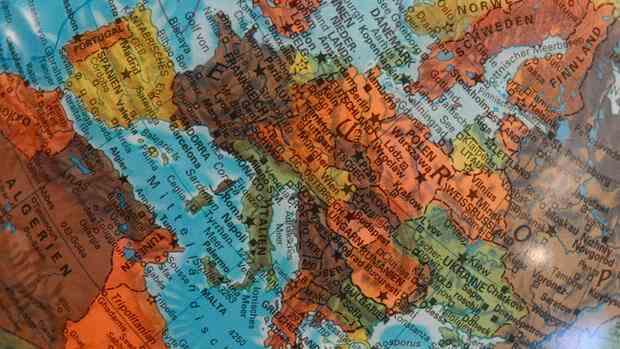Old maps register a new boom. Designated dealers sell them internationally for a lot of money, and enthusiasts, including people from the younger generation, use them. Not in everyday life, where you used to deal with plans folded like origami while riding a bike or driving a car. You hang them on the wall. Is this just a new retro wave, a nostalgic fetish?
Hardly likely. Maps illustrate marked territory, geographic spaces that also document the distribution of political power for the hoped-for eternity. It’s perhaps no wonder that printed maps are making a comeback just as nearly 95 percent of all cars in the world’s major cities are finding their way using GPS. At a time that changed last year, when a US military expert watched on Google Maps at around 3 a.m. on February 24, how numerous roads on the Russian-Ukrainian border were suddenly “closed”.
What looked like a “traffic jam” on Google Maps was the Russian military attack on Ukraine. GPS systems document live what previously had to be redrawn and printed on maps: the shifting of borders – geographical, political and moral.
Maps are therefore political documents and an attempt to cement power once it has been gained. Countries or organizations use geographic information, such as borders, to express their political views on a particular issue, i.e. to create facts. For example, if two countries are at odds over a particular territory, they can create different versions of the same map with conflicting claims about who owns which territory. These maps are then used by governments as a propaganda tool to influence public opinion.
This is exactly what we have experienced since the armed annexation of the Ukrainian peninsula of Crimea by the Russian military in spring 2014 – a permanent border crossing. A ceasefire and autonomy for the Ukrainian Donbass were subsequently reached in the peace negotiations between Ukraine, Russia, France and Germany. Russia refused to negotiate on Crimea. You don’t have to be a cynic to see the Ukraine war as an almost logical consequence. Crossing borders rarely comes alone.
Miriam Meckel is a German journalist and entrepreneur. She is co-founder and CEO of ada Learning GmbH. She also teaches as a professor for communication management at the University of St. Gallen.
(Photo: Klawe Rzeczy)
In 1962, the German-American theologian and philosopher Paul Tillich gave a remarkable acceptance speech on receiving the Peace Prize of the German Book Trade. Talking about the existence and nature of the “borders”, Tillich said: “If crossing the border and crossing it back is the way to peace, then the fear of what lies beyond and the will born from it to eliminate it, is the way Root of strife and wars.” Tillich further argued: “The aggression of the fanatic is the result of his weakness, his fear of overstepping his own limit, and his inability to realize in the other what he has suppressed in himself see.”
Tank deliveries: Still unimaginable a few months ago
Nothing against the boundaries between different positions per se. All forms of human existence grow out of a certain demarcation between alternatives. Who would I be without a you, what would day be without night, brightness without darkness and happiness without misfortune. Without differences that make a difference, as the British-American anthropologist Gregory Bateson once described, we would not be able to perceive and interpret our world. Identity also arises from difference.
However, it becomes difficult when this difference becomes an ideology, as Tillich describes. Democracy is just as threatening for the authoritarian fanatic as freedom of opinion is for the obedient propagandist. Limit crossings by extremists must be stopped. Otherwise they blur the line between distinction and discrimination to the point of annihilation.
The German federal government did this together with the US government last week. The delivery of Leopard 2 and M1 Abrams to Ukraine is an important step in showing Vladimir Putin a limit after numerous transgressions: “We will not allow a neighboring European country to be attacked by force of arms and incorporated today.”
>> Read also: Leopard 2 and M1 Abrams can do that
For German defense policy, this is a border crossing. A step like this would have been unimaginable just a few months ago. It is true that this is being discussed at length. And certainly the federal government could have communicated more intelligently in some places.
Life redraws all boundaries every day
But all hobby generals in the editorial offices of German-language newspapers, who would have made decisions so much more specifically, faster, more self-confidently and more efficiently, make things very easy for themselves. Your bellicose drivel is dangerous. What would their reactions be like if Putin, in his authoritarian delusion of self-preservation, used strategic nuclear weapons without a close German-American solidarity clearly showing that he cannot drive a wedge between the NATO countries.
The Polish-American philosopher Alfred Korzybski coined a sentence for all those who like to make it easy for themselves when it comes to such difficult demarcations: “The map is not the landscape” (“a map is not the territory”). No map can capture what it means to venture into the desolate landscape of war, and it’s well to give it plenty of thought beforehand. A wrong move doesn’t matter on the map, in the area it could be fatal.
So you can’t collect old maps to hold on to a past status quo. Life redraws all boundaries every day – on Google Maps and in reality.
In this column, Miriam Meckel writes fortnightly about ideas, innovations and interpretations that make progress and a better life possible. Because what the caterpillar calls the end of the world, the rest of the world calls a butterfly. ada-magazin.com
More: Generative AI opens a new competition between Google and Microsoft
